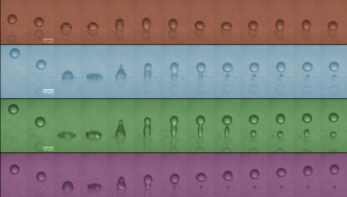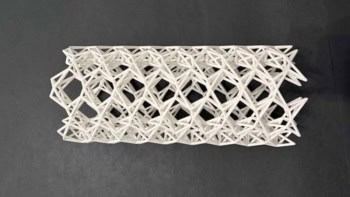It’s a solid that’s not a solid — it can flow effortlessly through normal matter as if it were not there. This is a supersolid in principle, but for at least five years the true origin of this state of matter, if it is indeed real, has challenged the both minds and experimental prowess of physicists.
Now two studies by researchers in the US are giving new perspectives on the mystery, although it is far from being solved.
In the first study, Nobel laureate Philip Anderson of Princeton University addresses supersolids theoretically. Contrary to present computer models, he claims that supersolidity can be explained as superfluid of atom vacancies in a solid lattice. Moreover, he says that all “bosonic” solids — those that contain atoms with integer values of spin — should be a supersolid in their quantum ground state.
In the second study, Seamus Davis of Cornell University and colleagues find evidence that supersolid signatures observed in other experiments actually suggest more of a glassy, rather than a crystalline, behaviour. In other words, the supersolids reported might be termed more accurately “superglasses”.
Strange signals
The first good evidence for supersolidity came in 2004, when Moses Chan and his graduate student Eun–Seong Kim of Pennsylvania State University studied samples of helium–4 inside a torsion oscillator. They found a spike in the frequency of oscillations below a temperature of about 200 mK, which implied some of the helium had become a supersolid and detached from the rest of the sample. Since then at least five other groups have reproduced Chan’s supersolid signals, although results from other studies have confused any understanding of the phenomenon’s origin.
The original theory of supersolids — given 40 years ago by Russian theorists Alexander Andreev and Ilya Liftshitz — said the strange behaviour would be caused at low temperatures when vacancies in a lattice of bosons “condense” into the same quantum ground state, and thus behave as a single, coherent entity. But recently computer simulations have shown that near absolute zero there should be few, if any, vacancies left. Experiments have also shown that disordered helium crystals seem to give stronger supersolid signals, which implies the phenomenon may not be an intrinsic property of bulk helium but rather a property of defects in the lattice.
Anderson’s theoretical study, in his own words, addresses these issues “from a different point of view.” He thinks today’s computer simulations do not have the capability to rule out vacancies. On the basis that vacancies exist, he investigates how their phase can change using the “Gross-Pitaevskii equation”, which is commonly used for studying atomic condensation in cold gases. He makes arguments for choosing various parameters based on experimental results, and predicts that vacancies would condense below 50 to 70 mK. More importantly, however, he predicts defects should attract vacancies and therefore magnify the supersolid signal, as experiments indicate.
Glassy dynamics
Davis’s group, on the other hand, has investigated what the dynamics of a torsion oscillator can say about supersolids. They came up with a theory that predicts the relationship between the energy-dissipation response and frequency response for any material inside a torsion oscillator at different times and temperatures. They then reproduced the torsion oscillator experiments with samples of helium–4 warmed abruptly from 50 mK to different temperatures up to about 300 mK.
They found that, given their predictions, the dynamics were more indicative of a glassy rather than the crystalline state. But because of the large size of the frequency shift, they say the state seemed also to have a “super” component. This means a likely explanation for the reported supersolid signatures is therefore a superglass — an amorphous solid that exhibits some superfluidity.
Chan says he is pleased Davis’s group has confirmed his group’s previous findings, and says it is “interesting and instructive” to examine the result in terms of glassy dynamics. He also thinks Anderson’s paper is significant, because it shows, as experiments indicate, that supersolidity can exist in both disordered and “perfect” helium crystals. Nevertheless he says many mysteries remain, such as the fact that the supersolid signature has been shown to vary by up to three orders of magnitude.
What is the ground state?
Boris Svistunov, a theorist at the University of Massachusetts who in 2006 helped predict the existence of a superglass state for helium–4, thinks the conclusions of Davis’s group are “remarkable”.
The most intriguing direction is cold atoms in a lattice, and people are doing that Philip Anderson, Princeton University
However, he has less praise for Anderson’s work. He thinks Anderson is mistaken when he says simulations are not powerful enough to rule-out vacancies, because all the simulations need to do is calculate the gap required to create just one of them. In addition, he claims Anderson’s assertion that every bosonic solid is a supersolid in its ground state is “wrong”. He points to research he published in 2005 in which he calculates that finite gaps for vacancy and defect sites cause non-supersolid, insulating ground states.
Anderson told physicsworld.com he expected his work to be controversial, and admits no-one yet has the experimental capabilities to examine other bosonic solids in their ground state and so lend weight to his assertion. “The most intriguing direction is cold atoms in a lattice, and people are doing that,” he says.
The research is published in Science.



